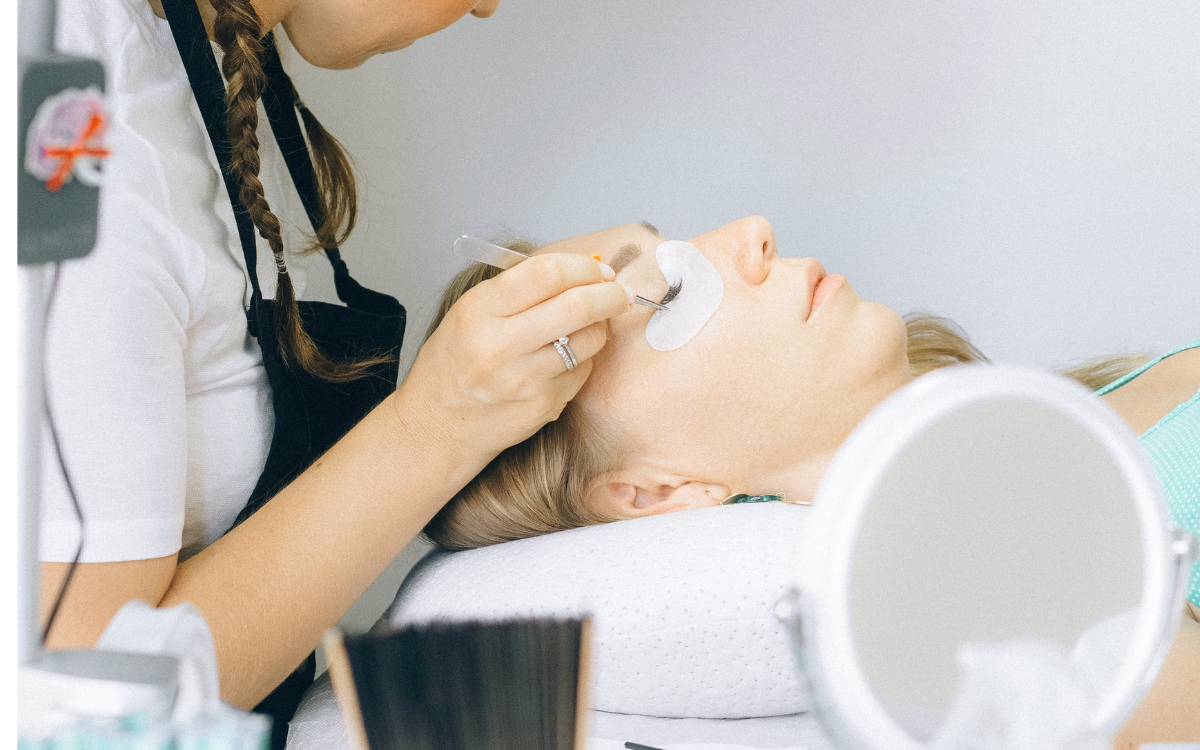When a customer texts us the day after a lash set and says, "I've had an allergic reaction!" we've all had that moment when our hearts stop racing, and our palms get sweaty—immediately followed by photos of their irritated, red, and puffy eyes!
But how are allergic reactions and burns caused by chemicals different? What measures can be taken to prevent them, and which populations will most likely be affected?
It's essential to get this out of the way first: our customers aren't allergic to their lashes, as you may have guessed from the previous sentence, so let's discuss that. It's not like what I'm about to say is earth-shattering or mind-blowing; it's been YEARS since eyelash extensions have been made from a hypoallergenic fiber called PBT rather than — as the names often suggest — Silk, Mink, or Cashmere. It's not like what I'm about to say is earth-shattering or mind-blowing. To keep a long story short, these are names to highlight a different appearance to the finish of the lashes.
Glue is the most frequently encountered cause of allergic reactions and chemical burns. Specifically, cyanoacrylate is the substance in question. You should know as well as anyone that the primary component of any lash glue is cyanoacrylate; in a nutshell, this substance is responsible for the adhesive properties of the glue. It is also a reasonably potent chemical, which means that it has the potential to irritate the skin under certain conditions.
How can you tell the difference between the two of them? In a nutshell, chemical burns occur on the inside of the eye, and you'll notice that your eyeball is red because it will be bloodshot. On the other hand, allergic reactions occur on the outside of the eye, and they cause the eyelids to swell and cause discomfort. Chemical burns occur inside the eye, while allergic reactions occur outside the eye.
- 1 Who may be affected by chemical burns?
- 2 What do we do when chemical burns happen?
- 3 Is it possible for a person to regain their lashes after suffering a chemical burn?
- 4 Who may be at risk for allergic reactions?
- 5 What can be done to minimize this?
- 6 What can we do when they react?
- 7 Do you know if someone who reacts could have their lashes done again?
- 8 Final Thoughts
Who may be affected by chemical burns?
To be more specific, anyone. If their eyes are flickering because they're a caffeine fiend (aren't we all?) or because they're chatty, if you were resting on the eyepatch with your isolation tweezers too hard and pushing the lower eyelid down (it's easy to do); or because they have bulbous eyes that won't completely close. A chemical burn directly results from the eyes being open during treatment.
How can you help them?
- Advise them to abstain from caffeine for at least an hour leading up to the treatment; doing so will stop the blinking of their eyelids, and it may also cause them to nod off, which will keep them from talking as much.
- During the procedure, secure the upper eyelid with a piece of foam tape or a coin that has been thoroughly cleaned to stop it from moving around too much and opening.
- Use foam tape instead of eyepatches under the eyes to prevent the fumes from getting into open eyes. The extra thickness of the foam tape helps a lot with this, especially on clients who have clients who have more prominent eyes.
- Check the eyepatch placement with a second set of eyes. If eyepatch tape or eye patches are placed too high, the wearer may experience discomfort, prompting them to automatically open their eyes.
- During the treatment, you should use a lash mirror to ensure your eyes are completely shut.
- Reduce the force you are applying to your isolation tweezers; this is a very common mistake that requires a little practice to correct, but the more you are aware of it, the better!
- Tell them to turn off all alarms and put their phone on silent because they should be able to enjoy this relaxation time.
What do we do when chemical burns happen?
Not much can be done, and there is no easy solution to these problems. The redness will subside in a few days, and most of the time, it appears to be worse than it feels. Because it will be sore and dry, it is a good idea to direct your client to a pharmacist so that the pharmacist can determine whether or not your client is worried or experiencing any discomfort. Remember that because we are not medical professionals, we should under no circumstances recommend to our customers that they take any medication, not even eye drops.
Is it possible for a person to regain their lashes after suffering a chemical burn?
Yes! Ensure that their eyes are closed, that's all. It is important to remember that if the chemical burn is going to be performed on your client each time she gets her lashes done, she may develop an increased susceptibility to allergic reactions. Because of this, avoiding chemical burns is of the utmost importance.
Who may be at risk for allergic reactions?
I'll say it again, everyone. It is more likely that your customer of five years, who has never reacted, will send you this text message instead of the person who came to you for the first time last week and had never had lashes before. I can hear you saying, "What?! " WHY?!' because an allergy to chemicals is accumulative; it is the result of the body building up a reaction over time and eventually telling you 'I don't like this!' - this is the reason why if we're doing bridal lashes for ANYONE, we do it at least one week before the wedding and infill if we have to - no full sets the day before the wedding. Do you have any idea how horrible an experience that would be?
That is not to say that EVERYONE will have a reaction or that new clients won't have one; it's just that some of us do. It is nothing more than a built-up sensitivity that can manifest at times. Allow me to illustrate with an example using myself for a while. I am allergic to bananas, tomatoes, kiwis, latex, and mushrooms (did you know that these things share an enzyme, so it is common to be allergic to all of these things? If you are allergic to one of them?). Mushrooms are my worst allergy. In addition, I have a sensitivity to milk. All of these things trigger a mild allergic reaction in me, and as I've gotten older, my allergies have evolved in response to new triggers. My sensitivity to mushrooms and other allergens like them has decreased over the years, but my intolerance to milk continues to grow. (I may have to give up ice cream one day, I welcome your sympathy). As a result of the fact that our cells completely regenerate every few years, it is not unusual for our bodies' responses to various stimuli to change.
What can be done to minimize this?
Not much at all. They will have an allergic reaction if they are allergic. Even if a client takes a break from getting lashes, you use slower drying glue (slower drying equals less cyanoacrylate), you use faster drying glue (faster glue equals more cyanoacrylate, yes, but it also means less exposure to fumes over a prolonged period), or you use a bonder (it cures the glue instantly after treatment, so there is once again less exposure to fumes), they may still have an allergic reaction. It is very difficult to predict whether or not they will react, let alone when they will react; however, the fact remains that once they have reacted, you should not provide any further treatment to them because doing so can only make the reaction worse.
But wait! I conducted a patch test on them!
Great! However, patch tests can never be relied upon to be completely accurate. When you perform your patch test, you will apply a few extensions to each eye, but you will use a significantly smaller amount of glue than you would for a full set. This is to ensure that the test results are accurate. When you do a patch test, you cover 10–20 lashes, whereas when you do a full set, you cover 80–150 lashes. This represents a significant increase in your exposure to glue fumes. In addition, because an allergic reaction is a developed allergy, the individual may be fine after undergoing a patch test. Then after a few appointments, they may have an unexpected reaction one day. This can happen at any time.
What can we do when they react?
You should recommend that they go to a doctor or a pharmacist as soon as possible to see if they can get some medicine to bring the reaction down. Still, you should also let them know that if they need the lashes removed, they MUST return to you to remove them because you have the appropriate product for this particular purpose. If you need to remove your eyelashes, choose a cream remover rather than a gel one because it is much simpler to target a specific area with the cream and does not run at all. If the reaction is extremely severe and the client's eyes are extremely swollen, it is best for the client to first calm the symptoms by taking the medicine she got from the doctor and only then come to you for removal. If the reaction is mild, the client can come to you directly for the removal. Why? Simply put, if the eyes are extremely swollen, they might cover the lashes, which will make the removal of the lashes challenging to perform and might add additional discomfort to a customer who is already in a lot of pain.
Do you know if someone who reacts could have their lashes done again?
It is advisable not to do so. We have discussed that this kind of reaction is cumulative, which indicates that each subsequent reaction is likely to be worse and not dramatic. However, if the body becomes extremely allergic to something, it may get anaphylaxis due to this sensitivity; that is something NONE of us want to happen! In addition, most insurance companies will refuse to cover you in this scenario because you will be administering treatment while being aware of a condition that should prevent you from receiving it.
If your client is adamant about getting lashes again, you should recommend that they take a break from having lashes for at least six months and then try a half set after that. Due to the high level of danger, exercise extreme caution here! Also, keep in mind that taking a break does not in any way ensure that the allergic reaction will not manifest itself.
You could also provide your customer with a lash lift treatment to improve the appearance of their lashes. In doing so, not only will you be able to keep the customers coming back to your establishment, but they will also have the opportunity to learn about the other wonderful services you provide.
Final Thoughts
Chemical burns and allergic reactions can and do happen to all of us, but it's never fun to deal with them. Hopefully, this will help clear up some of the confusion that may have been surrounding them.







